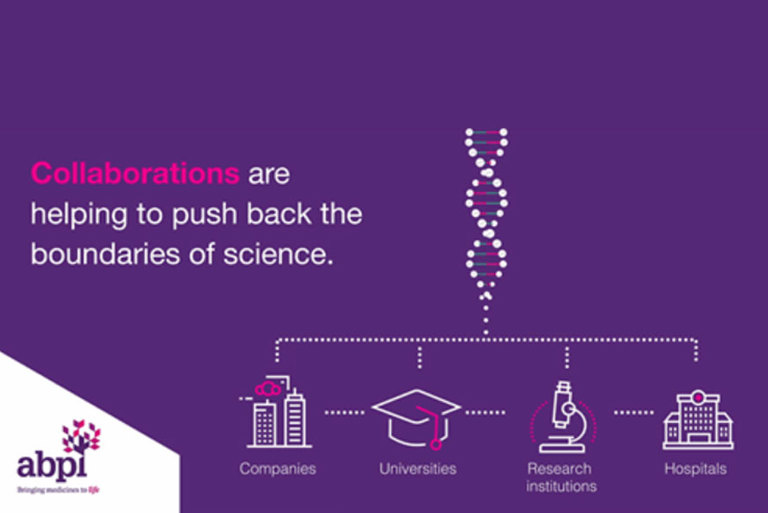Facts, figures and industry data

Headline pharmaceutical industry statistics
The figures below provide a snapshot of key biopharmaceutical sector statistics relating to the UK’s economy and health systems. Sub-national statistics can be found via the ABPI’s interactive Pharma Impact Map. International comparisons are available in several of the source documents and within the Government’s Life Sciences Competitiveness Indicators publication. Statistics on the economic and health system benefits which can be delivered through a supportive policy environment are available in the ABPI’s manifesto.
Economic statistics
£17.6bn
direct Gross Value Added (GVA) [1]
£45bn
R&D spillovers [2]
£9bn
investment in UK R&D (more than UKRI’s entire annual budget) [3]
£26.1bn
exports [4]
126,000
jobs [5]
£46.7bn
turnover [6]
Over 3,000
manufacturing and research sites combined [6]
£355m
revenue [7]
£28.6m
cost savings for the NHS in England through industry clinical trials in 2018/19 [7]
Health system statistics
9%
Amount the UK invests of overall healthcare spending on medicines – a significantly lower proportion than other advanced healthcare systems such as the United States (14%), France (15%), Germany (17%) and Japan (17%) [8]
42,088
patients recruited to industry clinical trials in 2022/23 (increasing from 36,722 in 2021/22, but below pre-pandemic levels of 58,048 in 2017/18) [9]
411
industry clinical trials initiated in the UK in 2022 (increasing from 394 trials in 2021, but below the 2015 peak of 690 trials) [10]
three-quarters
UK average uptake of medicines launched between 2017-21 is three-quarters the average uptake of comparator countries [11] with variation across the UK. For example patients in Derby ICS are 3x less likely to access new NICE-approved medicines compared to Norfolk or Surrey ICSs [12]
References:
[1] ONS, ‘Regional gross value added (balanced) by industry: all ITL regions’, 2021. Methodology available at: https://staging.sector-insights-map.abpi.org.uk/sources/
[2] ABPI, ‘Life Sciences Superpower’, June 2022, available at www.abpi.org.uk/publications/abpi-life-sciences-superpower-report/
[3] ONS, ‘Business Enterprise Research and Development statistics 2022’ available at https://www.ons.gov.uk/economy/governmentpublicsectorandtaxes/researchanddevelopmentexpenditure/bulletins/businessenterpriseresearchanddevelopment/previousReleases
[4] Office for National Statistics, ‘Trade in goods: country-by-commodity exports’, accessed 17 July 2024, available at www.ons.gov.uk/economy/nationalaccounts/balanceofpayments/datasets/uktradecountrybycommodityexports
[5] ONS, ‘Industry Census Data 2021’, available at: www.ons.gov.uk/datasets/TS060/editions/2021/versions/1 (methodology available at https://staging.sector-insights-map.abpi.org.uk/sources/)
[6] OLS, ‘Bioscience and health technology sector statistics 2021 to 2022’, available at: www.gov.uk/government/statistics/bioscience-and-health-technology-sector-statistics-2021-to-2022/bioscience-and-health-technology-sector-statistics-2021-to-2022#life-sciences-industry-by-sector
[7] NIHR, ‘Impact and value of the NIHR Clinical Research Network 2019’, accessed January 2024, available at https://www.nihr.ac.uk/news/new-report-highlights-how-nihr-support-clinical-research-benefits-uk-economy-and-nhs
[8] The King’s Fund, ‘How does the NHS compare to the health care systems of other countries?’, June 2023, available at: www.kingsfund.org.uk/insight-and-analysis/reports/nhs-compare-health-care-systems-other-countries
[9] Number of participants recruited to industry research studies in
the UK per year, as reported by the NIHR CRN, NRS, HCRW, and NICRN (2017/18-2022/23)
[10] Clarivate data, included in the ABPI’s report: ‘Getting back on track: Restoring the UK’s global position in industry clinical trials’, November 2023, available at www.abpi.org.uk/publications/getting-back-on-track-restoring-the-uk-s-global-position-in-industry-clinical-trials/
[11] Uptake ratios three years post-reimbursement (n=28 medicines), Office for Life Sciences, ‘Life Sciences Competitiveness Indicators 2023’ available at: www.gov.uk/government/publications/life-sciences-sector-data-2023/life-sciences-competitiveness-indicators-2023
[12] Local Uptake of NICE Approved Medicines in England and Wales, A Summary of Insights – June 2022, IQVIA report, commissioned by the ABPI
Industry data

Medicines and vaccines have helped deliver incredible improvements in patient health. This section looks at expenditure on R&D in the UK and around the world, clinical trials by phase and by therapy area and research intensity.

Cancer survival in the UK has improved over recent years, with more people living five years or more with the disease than ever before. However, despite this progress, cancer remains one of the UK’s leading causes of death. More can be done to improve cancer outcomes for those affected. By looking at how the UK compares to other European countries, we can begin to consider how this can be achieved.

An interactive report using anonymised data to analyse trends in collaborations between industry and academic institutions.

Medicines bring huge value to NHS patients. The development of new medicines is uncertain, costly, and involves significant rates of failure. The pharmaceutical industry spends $160 billion per year on research and development.
